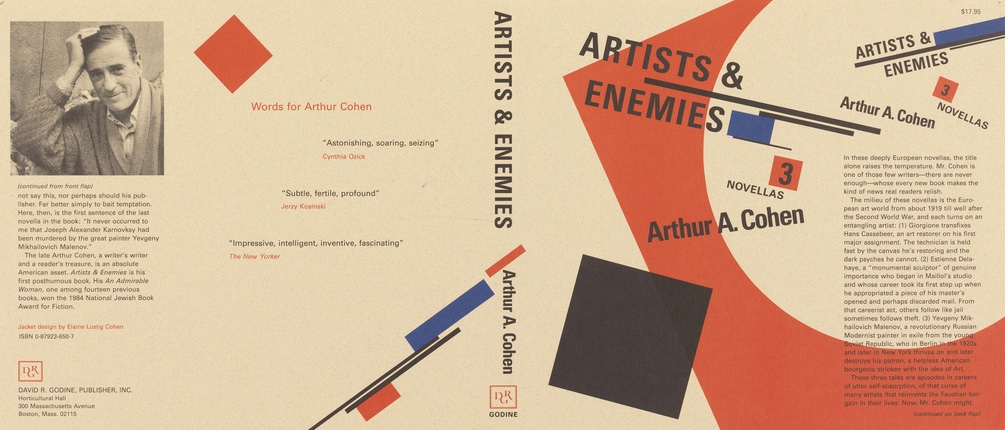
Elaine Lustig Cohen, Dust jacket for Artists and Enemies by Arthur A. Cohen, 1987
Curator’s Choice
Elaine Lustig Cohen and Herbert Bayer.
In Bauhaus Typography at 100, on view at the Bayer Center through April, the facsimiles of three works by Elaine Lustig Cohen (1927–2016) feature in the last section, “Beyond the Bauhaus,” which explores its legacy in the second half of the twentieth century. Cohen’s 1956 envelope and 1987 dust jacket (for Artists and Enemies) both relate to her second husband and bookend the years of their marriage. Arthur A. Cohen (1929–1986), a writer and scholar of wide-ranging interests, is a familiar name to Bayer aficionados: his survey Herbert Bayer: The Complete Work (1984) remains the most expansive study of the artist.
But his and Elaine Lustig Cohen’s (née Firstenberg) connection to Bayer and the Bauhaus goes back further. She may have encountered his work as an undergraduate at Tulane University in a Bauhaus-inspired design class. She also cited visiting, as a teenager, an exhibition devoted to Vassily Kandinksy (1866–1944) in Manhattan as especially formative. Her first marriage to graphic designer Alvin Lustig (1915–1955)—who is represented with three works in the current exhibition—would have brought her into contact with Bauhaus exile (and Bayer instructor) Josef Albers (1888–1976), who invited him to teach at Yale University in 1951.
By the time Elaine Lustig Cohen and Arthur A. Cohen started Ex Libris Rare Books in 1973, her knowledge of the Bauhaus was probably extremely well-rounded. Until 1998, when she closed the business, Ex Libris was a leading dealer of early twentieth-century European avant-garde books, periodicals, and ephemera—materials such as the flyers, invitations, and promotional pamphlets found in the Bauhaus Typography exhibition. They published special catalogs dedicated to, for example, Dada, Surrealism, Futurism, and Constructivism. The Bauhaus was a recurring focus, too. The cover of issue 11 even recalls the one Bayer designed for bauhaus magazine in 1928. For issue 15, Bayer’s work was coupled with that of Dutch designer Piet Zwart (1885–1977) under the heading Masters of Design.
Elaine Lustig Cohen and Arthur A. Cohen also collected major midcentury abstract paintings by Sonia Delaunay (1885–1979), Morris Louis (1912–1962), Robert Motherwell (1915–1991), and others. At one time, they owned Bayer’s watercolor Signs and Signals (1939) and a group of photographs that included Bayer. But this only scratches the surface. A voluminous archive that bears Elaine Lustig Cohen’s name in the Museum of Modern Art in New York contains dozens of graphic designs by Bayer, particularly examples of his different letterheads from the 1920s and 1930s. However, one of my favorite objects in that collection is more mysterious and not a work of art per se. An undated impression of Bayer’s fingerprint is recorded on a square of paper just over three inches. The bodily trace suggests both a shared personal history and a sacred relic.
Adam Thomas, PhD is Curator of the Resnick Center for Herbert Bayer Studies.

Ex Libris, Masters of Design: Herbert Bayer, Piet Zwart, 1988
more



